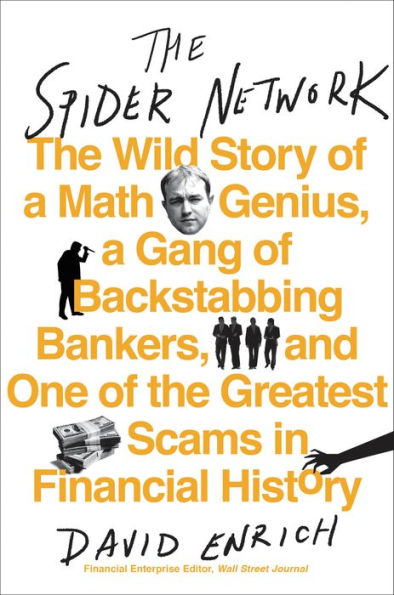SHORT-LISTED FOR THE FINANCIAL TIMES BUSINESS BOOK OF THE YEAR
The Wall Street Journal's award-winning business reporter unveils the bizarre and sinister story of how a math genius named Tom Hayes, a handful of outrageous confederates, and a deeply corrupt banking system ignited one of the greatest financial scandals in history.
In 2006, an oddball group of bankers, traders and brokers from some of the world’s largest financial institutions made a startling realization: Libor—the London interbank offered rate, which determines interest rates on trillions in loans worldwide—was set daily by a small group of easily manipulated functionaries. Tom Hayes, a brilliant but troubled mathematician, became the lynchpin of shadowy team that used hook and crook to take over the process and set rates that made them a fortune, no matter the cost to others. Among the motley crew was a French trader nicknamed “Gollum”; the broker “Abbo,” who liked to publicly strip naked when drinking; a Kazakh chicken farmer turned something short of financial whiz kid; an executive called “Clumpy” because of his patchwork hair loss; and a broker uncreatively nicknamed “Big Nose.” Eventually known as the “Spider Network,” Hayes’s circle generated untold riches —until it all unraveled in spectacularly vicious, backstabbing fashion.
Praised as reading “like a fast-paced John le Carré thriller” (New York Times), “compelling” (Washington Post) and “jaw-dropping” (Financial Times), The Spider Network is not only a rollicking account of the scam, but a provocative examination of a financial system that was warped and shady throughout.
SHORT-LISTED FOR THE FINANCIAL TIMES BUSINESS BOOK OF THE YEAR
The Wall Street Journal's award-winning business reporter unveils the bizarre and sinister story of how a math genius named Tom Hayes, a handful of outrageous confederates, and a deeply corrupt banking system ignited one of the greatest financial scandals in history.
In 2006, an oddball group of bankers, traders and brokers from some of the world’s largest financial institutions made a startling realization: Libor—the London interbank offered rate, which determines interest rates on trillions in loans worldwide—was set daily by a small group of easily manipulated functionaries. Tom Hayes, a brilliant but troubled mathematician, became the lynchpin of shadowy team that used hook and crook to take over the process and set rates that made them a fortune, no matter the cost to others. Among the motley crew was a French trader nicknamed “Gollum”; the broker “Abbo,” who liked to publicly strip naked when drinking; a Kazakh chicken farmer turned something short of financial whiz kid; an executive called “Clumpy” because of his patchwork hair loss; and a broker uncreatively nicknamed “Big Nose.” Eventually known as the “Spider Network,” Hayes’s circle generated untold riches —until it all unraveled in spectacularly vicious, backstabbing fashion.
Praised as reading “like a fast-paced John le Carré thriller” (New York Times), “compelling” (Washington Post) and “jaw-dropping” (Financial Times), The Spider Network is not only a rollicking account of the scam, but a provocative examination of a financial system that was warped and shady throughout.

The Spider Network: How a Math Genius and a Gang of Scheming Bankers Pulled Off One of the Greatest Scams in History
528
The Spider Network: How a Math Genius and a Gang of Scheming Bankers Pulled Off One of the Greatest Scams in History
528Related collections and offers

Product Details
| ISBN-13: | 9780062453006 |
|---|---|
| Publisher: | HarperCollins Publishers |
| Publication date: | 03/21/2017 |
| Sold by: | HARPERCOLLINS |
| Format: | eBook |
| Pages: | 528 |
| Sales rank: | 158,181 |
| File size: | 2 MB |
About the Author
Customer Reviews
Explore More Items
This exclusive ebook collection brings together the
A canny young woman is struggling to survive by perpetrating various levels
La ville de Wind gap dans le Missouri est sous le choc : une petite fille a disparu. Déjà l'été dernier, une enfant avait été sauvagement assassinée… Une
Sie war sieben, als die Schüsse fielen. Als sie in die kalte Nacht hinauslief und sich versteckte. Als ihre
Das Drama der Lusitania: Das Schiff, dessen Untergang den Ersten Weltkrieg entschied.
Am 7. Mai 2015 ist es 100 Jahre her, dass das amerikanische Passagierschiff Lusitania während des Ersten
Erik Larson has been widely acclaimed as a master of
A true story of love, murder, and the end of the world’s “great hush.”
In Thunderstruck, Erik Larson tells the interwoven stories of two men—Hawley Crippen, a very
David Grann reconstruye en esta fascinante novela la misteriosa historia del explorador Percy Fawcett, desaparecido durante la última expedición en busca de El Dorado.
Durante siglos, los
Vuelve el maestro del True Crime, David Grann, tras el éxito de Z, la ciudad perdida. Entre estas increíbles historias de crímenes reales, destaca «El viejo y la pistola»,
In the major league draft of 1971, the first player
Ray Atlee is a professor of law at the University of Virginia. He's forty-three, newly single, and still enduring the aftershocks of a surprise divorce. He has a younger brother, Forrest, who
